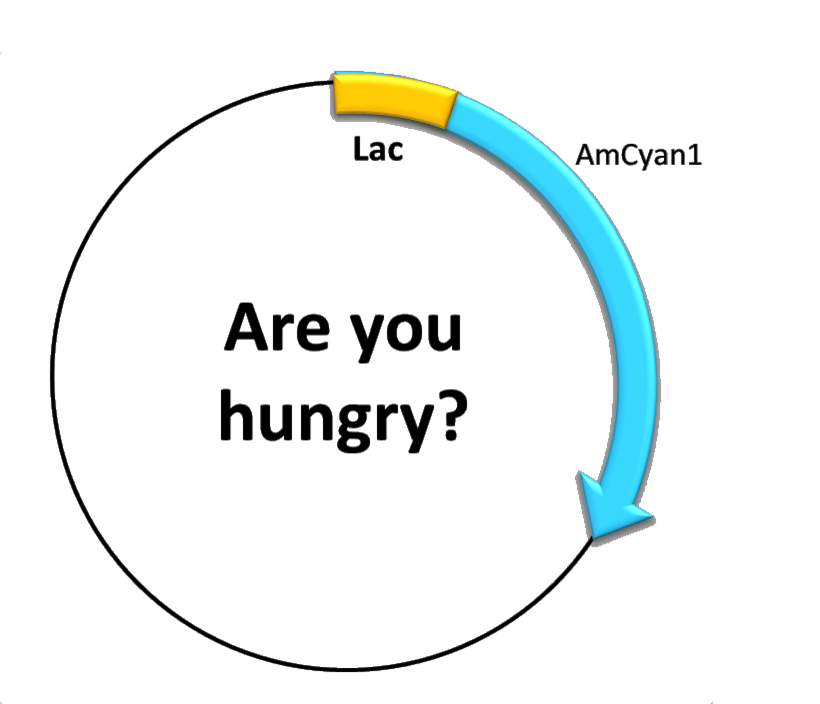Part:BBa_K763000
pLac + Gene encoding AmCyan
This construction is made up of three elements:
1. The transcription factor-binding site inside the promoter,
2. the repressor-binding site outside the promoter and
3. the coding sequence, which contains a synthetic fluorescent (blue) protein.
Our construction uses the well-known lactose operon system [1]:
When is the protein synthesized? In order to obtain the blue fluorescent protein two conditions have to be met. First condition: there is no glucose in the medium. Second condition: lactose is present in the medium (it also works with other inductors, like IPTG).
The molecular mechanism underlying this phenomenon is as follows: a lack of glucose promotes the formation of CAP (or CRP [2]), which binds to specific sites upstream of sugar-metabolizing genes and activates its transcription. The binding of this molecule depends on the presence of the allosteric effector cAMP (the concentration of this metabolite changes in response to the presence or absence of different nutrients). Moreover, another condition is needed since LacI repressor, produced constitutively by the lacI gene inside the lactose operon, will bind to the operator region and will block the transcription unless lactose is also present in the medium. Once lactose enters the cell it is converted to allolactose [3], and this molecule binds tightly to the repressor so it can no longer block the transcription. Then, the fluorescent protein can glow in the cytoplasm!
How did we deal with this construction? In our experiments we tested the differential expression when glucose is absent and lactose present (and vice versa). Furthermore, we tested the expression and growth rates when different compounds were added as supplementary carbon sources (for example, we added sodium acetate or galactose). We also determined the best IPTG concentration to get optimum results.
Characterization
The experiments with our glucose-sensitive construction were carried out by three different ways: (1) containing only glucose as a carbon source, (2) containing galactose as an extra carbon source and (3) containing sodium acetate as an extra carbon source, since we checked in previous tests that low concentrations of glucose compromised cell growth. All tubes had, in addition to the glucose gradation, also IPTG (see information on the molecular mechanism). For fluorescence intensity (FI) measures cell growth, i.e. OD600, was taken into account. We worked with a 0D600 close to 0.1 in order to be able to use high sensitivity in the fluorimeter.
As you can see in the graphs below, the less glucose you have, the more fluorescence you get. And this results replicate well when galactose (Figure 2) or sodium acetate (Figure 3) were added to the medium as supplementary carbon sources. The threshold for a boost in the fluorescence intensity seems to be 0.1 g/L of glucose, since from this concentration the values get really high. Normal values are 10 g/L, and we got the best results when we added 10-4 glucose concentration of that of the canonical values.
 |
| Figure 1. Fluorescence intensity (FI) normalized by the optical density of the culture (OD) for differents amounts of glucose present in the medium. |
 |
| Figure 2. Fluorescence intensity (FI) normalized by the optical density of the culture (OD) for differents amounts of glucose in a medium supplemented with 3 g/L galactose. |
 |
| Figure 3. Fluorescence intensity (FI) normalized by the optical density of the culture (OD) for differents amounts of glucose in a medium supplemented with 3 g/L sodium acetate. |
Sequence and Features
- 10COMPATIBLE WITH RFC[10]
- 12COMPATIBLE WITH RFC[12]
- 21COMPATIBLE WITH RFC[21]
- 23COMPATIBLE WITH RFC[23]
- 25INCOMPATIBLE WITH RFC[25]Illegal AgeI site found at 712
- 1000COMPATIBLE WITH RFC[1000]
| None |

